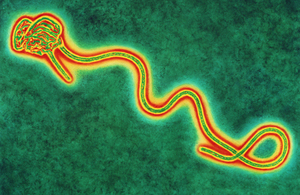
# 10, 233
Last summer, as the Ebola crisis in Western Africa gripped the world’s attention, we saw alarming reports warning that the Ebola Virus was Rapidly Evolving.
Specifically, that 99 Ebola viruses collected from 78 people from Sierra Leone in June of last year suggested that the virus was showing a marked propensity to accumulate `interhost and intrahost genetic variation’ as it passaged through the population.
This led to media reports such as Ebola virus mutating rapidly as it spreads from Nature News, and Ebola Is Rapidly Mutating As It Spreads Across West Africa via NPR’s Goats & Soda Blog. Worrisome, but as I noted at the time, while scientists can sequence and compare these variant viruses, they don’t necessarily know what these individual mutations (or their aggregate) means to the virus.
As we know now, the behavior of the Ebola virus has not changed appreciably over the past year, alleviating some of the immediate fears the virus might better adapt to humans as the chains of transmission lengthened.
In March of this year we saw an NIH study (see NIH: Ebola Virus More Stable Than Previous Study Suggested) that found the rate of mutation of the Ebola virus to be less than previously feared. This week, we’ve another study – this time from Public Health England – with has produced similar findings.
Scientists find Ebola virus' mutation rate only slightly higher than previous outbreaks.
The Ebola virus responsible for the outbreak in West Africa mutated at a similar rate to previous outbreaks, according to a new international study led by Public Health England (PHE) and published today (18 June 2015) in Nature.
Early in the outbreak, research suggested the virus’ mutation rate was twice that of previous Ebola outbreaks. However, PHE’s study has established that the mutation rate was only slightly higher than previous outbreaks, which is reassuring to public health experts around the world.
Granted unprecedented access to data covering a period of almost a year, the scientists analysed 179 patient samples obtained by the European Mobile Laboratory (EMLab), which was deployed to the epicentre of the outbreak in Guinea, to reveal how the Ebola virus mutated and spread.
The analysis confirmed that the Ebola virus was introduced into the Guinean population in December 2013 at a single source, supporting theories from epidemiologists (scientists who investigate the spread of disease). Scientists believe the virus was initially transmitted from a bat to a 2 year old boy in Guinea.
The team also established how the virus spilled into Sierra Leone from Guinea in April or early May 2014. Notably, a large number of the early cases in different regions of Sierra Leone can be linked to a single funeral.
Lead author Professor Miles Carroll, Head of Research Microbiology Services for PHE, said:
Our analysis shows the Ebola virus responsible for the current outbreak mutated at a similar rate to the earlier outbreaks in Uganda and the Democratic Republic of Congo. The results are good news for the scientists working to develop long-term solutions for Ebola, such as vaccines and treatments, as it means these new interventions should still work against the mutated strains of the virus. Currently, rehydration and replacement of critical elements appear to be the best way to improve a patient’s chances of surviving Ebola.
Following this study, we have theorised that one of the key factors in whether Ebola kills someone is the host’s genetic makeup rather than changes in the virus itself. Our next study will investigate this theory which may lead to improved treatment options.
We would like to acknowledge the collaborative efforts of a great many colleagues who worked on this study here in the UK and across the European Union and in Africa. In particular, this work was an opportunity to transfer skills and knowledge to our colleagues in Guinea as an investment in the public health infrastructure of the region.
A link to the Nature study follows:
Temporal and spatial analysis of the 2014–2015 Ebola virus outbreak in West Africa
Miles W. Carroll, David A. Matthews, Julian A. Hiscox, Michael J. Elmore, Georgios Pollakis, Andrew Rambaut, Roger Hewson, Isabel García-Dorival, Joseph Akoi Bore, Raymond Koundouno, Saïd Abdellati, Babak Afrough, John Aiyepada, Patience Akhilomen, Danny Asogun, Barry Atkinson, Marlis Badusche, Amadou Bah, Simon Bate, Jan Baumann, Dirk Becker, Beate Becker-Ziaja, Anne Bocquin, Benny Borremans, Andrew Bosworth et al.
Nature (2015) doi:10.1038/nature14594
Published online 17 June 2015
